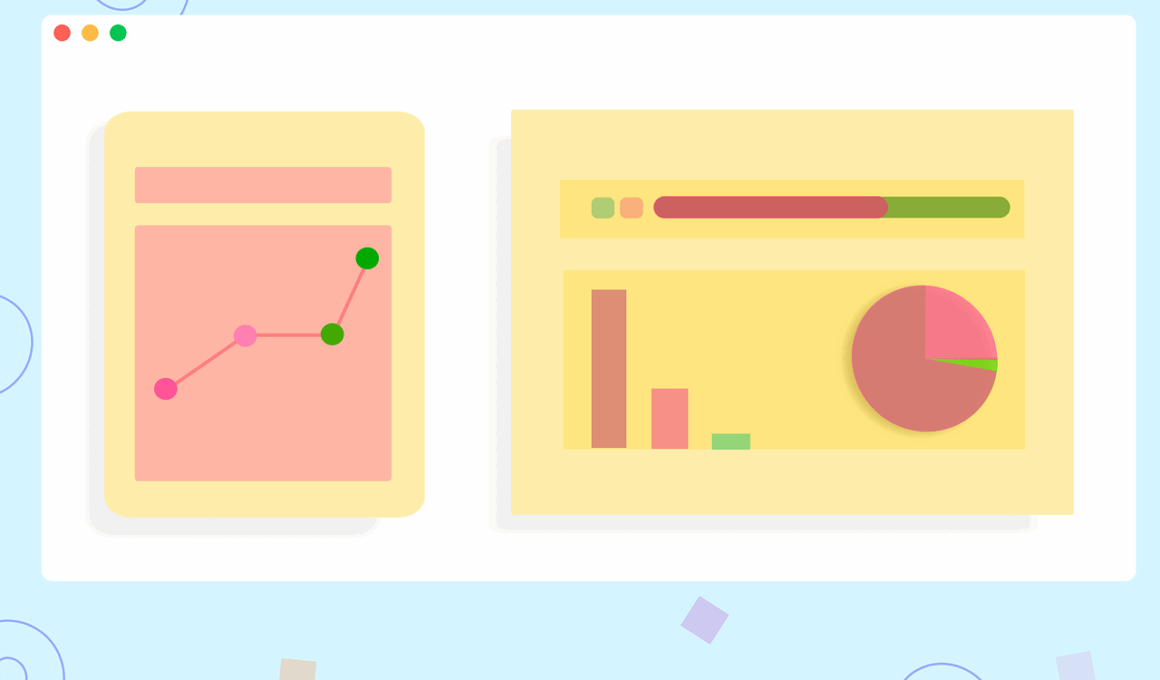Performance Dashboards for Small Businesses: Getting Started
Performance dashboards serve as essential tools for small businesses aiming to enhance their operational efficiency. By consolidating critical data into visual formats, these dashboards transform raw statistics into actionable insights. Small business owners can monitor key performance indicators (KPIs) in real time, enabling them to make informed decisions swiftly. Dashboards can display a variety of areas, from sales and customer service to financial metrics. Implementing a dashboard requires a clear understanding of business goals. Selecting the right metrics to track is crucial for success. Effective dashboards present data in a user-friendly way, often employing graphics such as charts or graphs to highlight trends. Transparency in performance tracking fosters accountability within teams. For small businesses, real-time tracking can indicate areas of improvement, helping prioritize resources efficiently. It is vital to choose a dashboard solution that integrates seamlessly with existing tools. Providers offer cloud-based solutions frequently to enhance accessibility and collaboration. Finally, investing time in training employees on using performance dashboards can vastly improve their effectiveness and overall impact.
Understanding your business’s specific needs is the first step toward creating an effective performance dashboard. To achieve this, gathering input from employees who will use the dashboard is essential. Different teams will likely have varying metrics they deem as priorities. Engaging these stakeholders ensures a comprehensive view can be developed. This dialogue can also reveal which data sources are most relevant, thus shaping how the dashboard should operate. Regularly reviewing these metrics can identify patterns and highlight necessary operational adjustments. With specified goals, you can then choose a dashboard template that aligns with your requirements. Various software platforms provide customizable options catering to small businesses. It is important to evaluate features such as ease of use, scalability, and integration capabilities. Some software may offer pre-built KPIs specific to various industries, which saves time. Additionally, reflect on how often you will need to update dashboard data. Establishing a routine for review encourages continuous evaluation and proactive adjustments. Beyond just functionality, the dashboard’s design significantly affects engagement levels, as a clear, appealing layout can motivate more frequent use.
Choosing the Right Tools for Your Dashboard
When selecting performance dashboard tools, consider both budget and functionality. Small businesses need affordable options without sacrificing essential capabilities. Numerous platforms offer tiered pricing, so assessing long-term needs is advisable. Look for dashboards with user-friendly interfaces that facilitate easy navigation among team members. A tool that allows customization is preferable, enabling adjustments as your business evolves. Moreover, ensure that the chosen software can link with other systems already in use, such as customer relationship management (CRM) or accounting platforms. This integration helps maintain consistent data accuracy across all departments. Security is another crucial aspect; therefore, review each solution’s data protection measures. It is essential that your business’s sensitive data stays protected from unauthorized access. Furthermore, customer support should be reliable and readily available in case users encounter challenges. Engaging in community forums and user reviews can also provide insights into typical issues encountered. Many vendors offer trial periods, which can be beneficial for testing usability before making a commitment. Ultimately, this careful evaluation can greatly enhance your dashboard’s efficacy, ensuring it meets your business objectives.
The implementation phase involves not only setting up the dashboard but also ensuring that it aligns with your operational strategies. Once you have chosen a platform and customized your dashboard, begin the data integration process. Collaborate with your IT team to connect all necessary data sources. It’s vital to ensure the data is clean and formatted correctly; this simplifies the visualization process immensely. Establish clear parameters for data input, so integrity is maintained. After the integration, run preliminary tests to verify that the dashboard accurately reflects your key metrics. Encourage feedback from your employees during this initial testing phase; their insights can lead to fine-tuning before broader deployment. Following the successful testing, conduct training sessions to encourage users to engage with the dashboard fully. Explaining the benefit of each metric displayed will foster a positive attitude toward the new tool. Continuous support during the first weeks post-deployment is important. Furthermore, set up regular check-ins to address questions or concerns as users become accustomed to the new system. This ongoing engagement will enhance acceptance and utilization rates, maximizing the dashboard’s overall effectiveness.
Monitoring and Refining Your Dashboard
After launching your performance dashboard, it’s time to monitor its effectiveness continuously. Frequent evaluations allow you to recognize whether the chosen KPIs remain relevant over time. Business environments can change, and adaptability is key to maintaining an effective dashboard. Regularly solicit feedback from users regarding their experience and whether the data meets their needs. It’s also a good idea to schedule periodic meetings to discuss dashboard performance as a team. These gatherings can illuminate insights that may not have been apparent at first glance, revealing deeper trends. Periodically review which metrics have been most beneficial for decision-making and consider adding new ones or removing outdated metrics. Conversely, managers should remain vigilant for any discrepancies or inconsistencies in the data. Timely identification of these can prevent potentially erroneous conclusions from being drawn. Data visualization methods should also evolve; refreshing the design can help sustain user engagement. As your business grows, it is essential to revisit and refine your dashboard to ensure it remains a powerful tool, guiding informed strategies and delivering key insights to foster sustained growth.
The long-term benefits of performance dashboards extend far beyond their immediate contribution to strategy. These tools can foster a culture centered around data-driven decision making. When team members regularly engage with performance metrics, this strengthens accountability and transparency throughout the organization. Over time, companies can develop a more systematic approach to tracking goals and outcomes. This often leads to improved efficiency and productivity since employees can pinpoint precisely where their efforts lead to results. With increased visibility into progress, businesses can pivot strategies as necessary. They also become better equipped to forecast future initiatives based on historical data. Furthermore, as stakeholders recognize the value dashboards offer, more resources could be allocated to their development and optimization. This empowers businesses to adjust their approaches continuously. Aside from operational enhancements, performance dashboards can also improve customer satisfaction by tracking responses and service metrics. These insights enable organizations to react proactively to customer needs. Ultimately, investing in effective performance dashboards is an investment in your company’s future, promoting growth and agile response processes.
The Future of Performance Dashboards
As technology advances, the future of performance dashboards is promising. Emerging technologies such as artificial intelligence (AI) and machine learning are poised to revolutionize how data is analyzed and presented. These developments can lead to predictive analytics, allowing businesses to anticipate needs rather than react to them. Small businesses that adopt these advanced capabilities may gain significant competitive advantages. Enhanced automation features could streamline data collection and reporting processes. Furthermore, the incorporation of real-time updates means more accurate, instantaneous insights. Visualization techniques are also evolving, with augmented and virtual reality offering new ways to experience data. This can allow users to interact with dashboard data in three-dimensional formats, enhancing comprehension. Additionally, mobile access will likely become a standard feature, giving business owners and employees the ability to engage with their metrics from anywhere. By keeping an eye on industry trends, small businesses can stay ahead of the curve. They will be positioned to adapt accordingly, making the most of performance dashboards as dynamic tools that grow along with their organization’s needs and aspirations.


